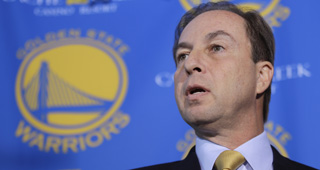Since the early days of the current Collective Bargaining Agreement, people in various parts of the NBA world have brought up the significance of the repeater tax. This point of conversation comes about for a pretty simple reason: when teams are subject to it, the repeater tax carries a hefty price tag.
Larry Coon gives a great example of this in his invaluable CBAFAQ: If a team in the 2015-16 season wants to have team salary up to the apron (always $4 million above the luxury tax line), a non-repeater would owe $6 million in luxury tax payments while also forgoing the payout from that fund received by teams that stay under it like all tax teams. At that same $4 million above the tax line, a repeater team would have to pay $10 million in luxury tax (along with the same foregoing as before) and that example only hits the lowest tier of the scale. With rates that increase every $5 million a team goes over, it should become clear how potential bills could get out of hand quickly.
With those kinds of consequences in place, it makes sense for franchises to exercise more fiscal restraint. Furthermore, the 2014-15 season will be the first in the current CBA to have the repeater structure in place so the clock is ticking for some of them.
The combination of legitimate concern from teams and a lack of understanding from those who cover them has produced an atmosphere where teams skirting the tax one or more times gets met with understanding as has been the case with the Golden State Warriors each of the last few seasons, starting with when they dumped Jeremy Tyler and Charles Jenkins at the 2013 trade deadline. A fringe playoff team shedding some small contracts can be justified so fans and media members alike largely shrugged off the decision. Those kinds of moves on the margins work in both a narrow sense because shifting from over the tax to under has other financial ramifications like the ones mentioned above and because it delays the dreaded repeater tax that can bring even the strongest franchises to their knees.
One problem with that: while the new CBA established a heavily punitive repeater rate, it also made getting there incredibly difficult. After the current season, the only way for the repeater rate to come into play is if a team paid the luxury tax in three of the four previous seasons. That may sound more likely but remember that we are talking about “previous seasons” and not the current one since a team presently under the luxury tax line will not pay anything on it even if their prior history was living over the tax line every season. That means that a franchise must actually pay the tax four out of five years with the under year not being the current one.
To use an example, if the Golden State Warriors stay under this season, the absolute soonest they could be subject to the repeater rate would be 2018-19 if they go over every possible time. Only one player on the team is under contract for even the year before that season: Klay Thompson. By then, the salary cap (and thus the luxury tax) will fully reflect the massive new national TV deal and large contracts like David Lee’s will be distant memories.
The other major factor to consider is that the shortening of contract lengths made it substantially less likely that a team will pay the luxury tax long enough to fall into the repeater grouping. Even the Los Angeles Lakers who still had a cap holds for John Salley and Karl Malone on the books until recently because they never had a reason to go under the cap have cleared the luxury tax because the incentives of cap flexibility are just too great. Ledgers like Brooklyn’s are a relic to the old system and fans of the teams that have not gotten with the times can appreciate their ill effects.
While the repeater tax has some real teeth, the current Collective Bargaining Agreement created a world where it lives more as a threat than reality.



